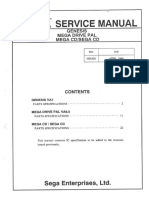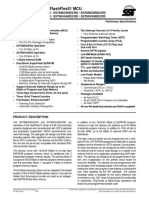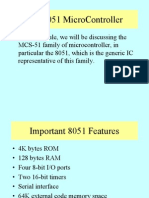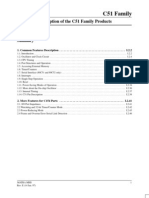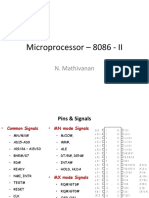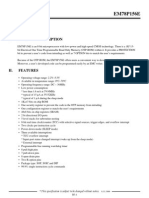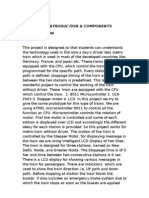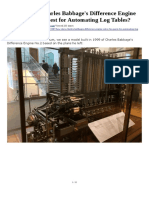0 ratings 0% found this document useful (0 votes) 86 views 5 pages TS1000 Machine Code Development System
An article from The January issue of Computer Digest. The article details a means of converting the Timex 1000 (Sinclair ZX81 in the UK) into a Z80 machine-code development system including hardware interrupt and ROM emulation.
Copyright
© © All Rights Reserved
We take content rights seriously. If you suspect this is your content,
claim it here .
Available Formats
Download as PDF or read online on Scribd
Go to previous items Go to next items
Save TS1000 Machine Code Development System For Later MACHINE CODE
DEVELOPMENT SYSTEM
FOR YOUR TIMEX SINCLAIR 1000
Turn your Timex Sinclair 1000 or Sinclair ZX81 into a
high-speed, machine-code development system.
MARK W. LATHAM
By now you may have seen dozens of Timex Sinclair
1000)Sinclair ZXB7 add-on projects in various electronic
magazines. It not surprising considering that at one
time, Timex was shipping 100,000 units a month, While
some people are content to fool around with whatever
they cen hook up to the back of the unit, others have
bought real keyboards and extra RAM, hoping to turn
their computers into real business or entertainment
machines.
if you've ever used a Timex Sinclair 1000 (which
welll simply call a TS 1000 from here on), you know that
speed keeps that computer from serving any useful
Purpose. You could take a short nap while the
computer is Ioading even a 16K program from cassette.
‘Once it’s loaded, you run into the other speed
problem—execution time. Thats because the ZB0A
CPU spends most of its time updating the video, and,
let’ face it, the BASIC is too slow, even in the FAST
mode. The simplicity of the TS 1000, which is one of its,
virtues, is 850 its downfall
if you own a TS 1000 and want to tum it into @ useful
device, why not consider the following: 1) run high-
speed machine-language level programs and, 9) store
those programs in EPROM.
This project, 8 machine-code-development-systern/
EPROM-programmer, will let you do just that. With it,
You can use your TS 1000 to load joragrams from
EPROMS, and program EPROMS with data anywhere in
the RAM. You will be able to store and recall 4K bytes
Of battery-backed-up external CMOS RAM. Also, the
unit can bbe disconnected from the 75 1000 and used
to emulate en EPROM for a different microprocessor.
You will be able to use the EPROM programmer as a
general VO port, each line of which is monitored by
LEDS. The LED's are great if you are just learning
machine language commands. Of those lines, 90 are
available for inputioutput, while four others are
Configured as output-only lines capable of sinking 500
mA each. All those lines are available through @ socket
in the back of the unit and, if you hook them up with a
test clip, you will have a five-volt, multi-channel logic
monitor with both LED and on-screen viewing. Best of
all, the whole EPROM /O system operates under
machine-lenguage leve! software control, which is, of
course, steved in EPROM.
System architecture
The unit is interfaced to the TS 7000 with an 8255 PPI
(parallel peripheral interface) VO port. We could have
‘Ueated the program socket as a memory space
accessed directly by the Z80A, but then we would
have had to insert many wait states during the program
pulse. Unfortunately there is no way the CPU can
refresh dynamic RAM during waits so that option is out.
‘What we must do then is create a second bus system
4s shown in Fig. 1, the schematic diagram.
Gates IC1-c and IC2-c allow the Z80A to access the
8955 when A7 and iowa are low. (A7 is included to
ensure that there will be no erroneous writes to the
8955.) If we leave the 82558 AQ and Al lines set for all
VO operetions, the computers monitor system won't
crash during /O operations regardless of whether the:
‘computer isin the fast or slow mode. The A4 and AS
lines of the Z80A are used to control the 82558 A@ and
Al inputs, 80, in hexcidecimal, the VO addresses will
‘be O3H, 93H, and 33H.
The 8955 has three eight-bit ports, one of which is
bit-addressable. Port € (PB4—-PB7) will function as the
secondary bus control outputs. Port B (PBO-PB7) will
function as the data VO port, and ports C (PC3-
PCO) and A (PA@-7) will function 3s acidress outputs
©-11, respectively. (The reason PC3-PCD are used in
reverse 25 AD-AS is twofold; that both simplifies circuit
‘board layout and arranges the bus and LED's for use as
4 logic monitor, as you will see later)
When the 8955 is reset (either by the computer or on
power up) all the ports are Configured as inputs. Any
time those ports are changed from inputs to outputs,
or vice-versa, all the port registers are reset. That
presents ¢ problem for the contro! lines in our
secondary bus system because those lines must remain
high (set) until a memory access is desired. Transistors
QI-Q# are used to alleviate that problem. If a ports
input or output is low, the corresponding transistor
output is high, holding the control line secure. If the
data in the CMOS RAM is of no importance, then those
transistors may be used as high current outputs,
capable of sinking up to 500 mA each,
The CMOS RAM, IC9 and ICI, and the CMOS one-
of eight decoder, IC7, provide 4K of data storage for
program saving and ROM emulation. The decoder
ANUARY 1985 — ComputerDigest 7�FIG. \—COMPLETE SCHEMATIC DIAGRAM. Reference the
diagram carefully while reading the text, as it helps clarify
some of the more-complicated points.
8 ComputerDigest — JANUARY 1985�JANUARY 1985 — ComputerDigest 9�FIG. 2-FULL-SIZE CIRCUIT BOARDS are provided here for
those readers who desire to duplicate the boards from
scratch, Note that the main board is shown in @ and the
display board in b. The boards are double-sided; the side
shown here is the component side.
sv inenes >| ke 2 inenes >|
a 6
PARTS LIST
Resistors 05, D6—1NO14
All resistors are 1/4 watt, 5% ‘DBi—ABI5I 1.5-amp, 50 volt, diode bridge
R1—220 ohms Q1-Q18—MPSAI3-
R2-R4, R32-R35, R37, R3E-A43—12,000 ohms
R5-R7—18 ohms
R8—47 ohms
R9-R31—270 ohms
R36, R47—39,000
R38—1 megohm
F44—56,000 ohms
F45—10,000 ohms, potentiometer, PC mount
R46—2.2 ohms,
Capacitors
C1-C4, C7, C13—0.1)F, ceramic dis
C5—100uF, 16 volts, miniature radial electrolytic
C6, C11—10uF, 16 volts, miniature radial electrolytic
C8—470uF, 16 volts, miniature radial electrolytic
C9-220,1F, 35 volts, miniature radial electrolytic
C10—2200j.F, 25 volts, miniature axial electrolytic,
Ct2—t0pF, ceramic disc
‘Semiconductors
Di-D4—1N4001
reads FANGS (PCT) and ATI to select the appropriate
memory IC, Those three ICS are powered by either the
five-volt supply through D1 or the lithium three-volt
10 ComputerDigest — JANUARY 1985
LED1, LED6-LED9, LED!¢-L8D17, LED22-LED25—
ted LED, XC5S6R or equivalent
LED 2—yellow LED, XCS56Y or equivalent
LEDS-LEDS—tnicolor LED, XC5491 or equivalent
LEDI0-13, 18-21—XC556G
ICt—74L810 tripe 3-input Nano gate
IC2—74L$27 triple 3-input No gate
1C3P8255 programmable peripherial interface
IC4—1C8—74L8240 ociai buffer
IC7—74HC198 3 to & decoder/multinlexer
IC8—2716 EPROM
ICo—723N positive adjustable regulator
IC10, IC11—HMe116LP-4 CMOS static RAM
1C12—780S §-vot! tequlaior
Miscellaneous
Ti—12VAC, 1-amp, walhplug transformer
P1—coaxial power plug
JI—coaxial power jack
St-9PDT switch
boattery through D2. Pin 6 of the decoder monitors the
five-volt supply and disables the RAM when the power
is off�FIG, 3--THE SOLDER SIDE OF BOTH BOARDS (the main
boards shown in a; the display board in b) is given here, also
full size. Both boards can be etched at once and then cut
apart,
4-1/4 INCHES:
a
S2—SPST switch
S3—DPDT switch, center-otf
Hi—50-centact,right-angle header
H2—26-contact header
PROGRAM SOCKET—24-pin ZIF socket with extender
pins (or wire wrap socket)
PC boards, IC sockets, enclosure, hardware, ribbon
cable, caid-edge connector, DB-25 connector, etc.
‘The following are available from Wildonics Comput-
er Technologies, P.O. Box 1763, Boise, ID, 83701:
Complete kit of all parts including power supply, all
connectors, lithium battery, PC boards, and case
(does NOT include 2716 EPROM with Operating Sys-
tem), $149.95; 2716 EPROM with Operating System,
$19.95; set of drilled and etched PC boards only
$19.95; Assembled and tested unit with Operating
Sysiem Software, $219.95. Shipping, handling and
insurance, $3.00 for EPROM with software or PC
boards only. $6.00 for complete kit or assembled
unit.
With $3 set for mic and the 8255% ports al
configured as inputs, a secondary CBU can directly
access the CMOS RAM through the proceam socket.
ef ances sf
b
Setting $2 for mic simply omties the RANE end the
RONG: lines and bypasses Vpp-blocking diode D5
Resistors R38 and R39, and transistor Q8, which
normally act as an inverter for the RESET signal, hold the
8255 reset if the EPROM-/O unit is used apart from the
7X81 during a mimic operation.
‘When $3 is set to paoceam, the outtout of the Vop
switching regulator IC9, is connected to the
appropriate EPROM V/O pin. we (PC7) contiols the
regulator’ output by sourcing the base of the
regulator's current limiting transistor For thet application,
that transistors emitter is connected to ground.
Capacitor C12 is connected to the frequency-response
in to slow the Vpp ise and fall times. Diodes D3 and
D4 and capacitors C8 and CY act as a voltage doubler
to provide 30 volts at 60 MA to the regulators input.
All the bus lines can be monitored with the display
bboard, Three 74152405, IC+IC6, power the LEDS. Red
LEDS (LED6-LE09, LEOT4 LEDIT, anc LED22-1ED25) are
Used for the the address lines and the LEDS for the date
lines (LED10-LED'3 and \ED18-LEDI7) are green. Those
LEDs will ight when the corresponding ‘bus lines are
high or high-impedance. The yellow LED (LED9) will
light if the WieVer line is tow.
Whille we are out of soace, we're not our of things to
say. We'll finish up next month <{p>
JANUARY 1
—ComputerDigest 11
You might also like Sega Service Manual - Genesis, Mega Drive PAL, Mega CD - Sega CD, No 010, April, 1994 PDF
Sega Service Manual - Genesis, Mega Drive PAL, Mega CD - Sega CD, No 010, April, 1994
32 pages


